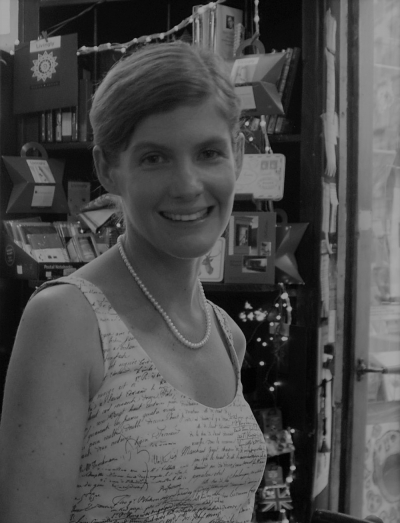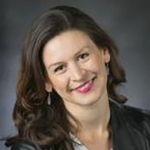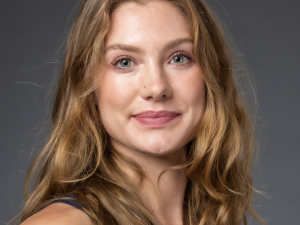Alumni Profiles Series: Virginie A. Duzer

Virginie A. Duzer is a scholar of late nineteenth, twentieth and twenty-first century French literature, art and culture. She received her Ph.D. in Romance Studies from Duke in 2008. Currently, Duzer is Associate Professor at Pomona College where she also serves as the Chair of the Romance Languages and Literatures Department. Her research deals with the relation between texts, images and aesthetics in avant-garde movements. She is author of L’Impressionnisme littéraire (Presses Universitaires de Vincennes, 2013) and is currently working on a new project entitled Le Mobilier de la couleur.
WHAT DREW YOU TO A DOCTORATE IN ROMANCE STUDIES? WHAT WERE YOUR CAREER GOALS COMING INTO THE PROGRAM, AND WHAT STEPS DID YOU TAKE AT DUKE TOWARDS THOSE GOALS?
I first came to the United States via an exchange program through my home institution, Université Michel de Montaigne, Bordeaux III, en route to complete my Maîtrise in French as a Second Languages (FLE). I received a Master of Art, with a specialization in French, from the Department of Modern and Classical Language Studies at Kent State University. It was during the M.A. that I first got a feel for higher education in the States. I was introduced to the American concept of a seminar-style class through the courses I took in French literature taught by Richard M. Berrong and Maryann De Julio, and really fell in love with the way small-group situations promote in-depth discussions, interactions with one another and with the texts in question. That is when I knew I wanted to do a doctorate in language and literature so I could be the facilitator of that type of collective learning environment.
During my six years as an international graduate student, I was fortunate to have a lot of support; the Graduate School was wonderful in that respect. One of my most formative experiences was participating in the Preparing Future Faculty (PFF) program in 2007—I’ve even held onto the materials from that year as a fellow! At that time, it was a little harder to find a faculty mentor [at a PFF partner institution] in the Humanities. I was matched with Jane Romer at Elon University, who was lovely. Between all the events Hugh Crumley and other Graduate School staff put together and the opportunity to shadow my mentor, I think PFF was important mental preparation for the job market and for interviews. If you participate in this type of programming and the shadowing it entails, you have actually been—even if briefly—in a faculty member’s shoes. And that makes you very different from other candidates.
I was finishing my dissertation and applying for jobs right as the financial crisis hit in 2008. However, I feel really lucky because I still managed to get my foot in the door; I had several interviews during the MLA (Modern Language Association) conference, which were followed by four campus visits, and I ultimately chose an offer from Pomona College—where I am now. At Duke, there were lots of opportunities to practice interviews; the Romance Studies Department and the Graduate School offered phone interviews and in-person interview practice.
The advice I received from my adviser, David F. Bell, to prepare several syllabi on various topics—not just those related to my dissertation—also proved very helpful. I have learned in retrospect that part of the challenge of hiring recent graduates fresh out of doctoral programs is that they are still in student mode. During the doctorate we are taught to be in student mode until we defend. But in a hiring search the other faculty members are looking for a colleague: they want you to be ready, responsible. They are looking for a peer and not for someone to babysit. I came to interviews with the syllabi, already able to talk about what my classes would look like. As a graduate student you have to prepare yourself for the different roles being a professor entails; and with rare exceptions that is no longer just sitting in your office, reading and writing books.
TELL ME MORE ABOUT YOUR CURRENT JOB. WHAT IS YOUR FAVORITE THING ABOUT WHAT YOU DO? WHAT HAS BEEN THE MOST SURPRISING THING ABOUT IT?
I am currently Associate Professor of French at Pomona College where I have also served as Chair of the Romance Languages and Literatures Department since 2015. As the founding member of the Claremont Colleges, Pomona’s format is truly unique. Our campus has the feel of a small college—with the shared resources of the entire consortium. For faculty it means that we are expected to demonstrate excellence in the three areas; teaching, research and service. Coming from an R1 like Duke, I was excited about continuing with high-level research and I, of course, loved teaching, but the service component was perhaps the biggest surprise. I mentor a new cohort of undergraduates every year—along with those planning to major in French—and I’ve served on innumerable committees.
I remember that during my campus visit to Pomona I was taken by the California-style liberal arts vibe. I had never been to California before, and neither Kent State nor Duke were liberal arts institutions, so it was very different. However, that focus on teaching aligned well with my career goals, and I have never grown tired of my daily interactions with my students, who are all undergraduates.
I have the impression that, with graduate students, advisers wrestle with the confrontation of their own mirror image. Of course, their advisees might actually be totally different from them in terms of working habits or desired outcomes but, at the outset, here is someone with your same interests and goals. With my undergraduates, I am handling diversity in all its complexity. It is my job to guide someone, with the help of French Arts and Literature, through this definitive moment in their life, whether or not we have anything in common. And that’s the beauty of it!
WHAT HAS YOUR TRAJECTORY BEEN AS A SCHOLAR? WHAT PROJECTS DO YOU HAVE IN THE WORKS RIGHT NOW?
The transition to Pomona went great as far as research was considered. The support here for research is very strong. I don’t have research funds, but I am always able to attend conferences and have received a number of summer research grants. I have also been the lucky recipient of the Albert and Elaine Borchard Foundation Center on International Education grants both in 2011 and 2017. I also had the great chance to reside and write in the Chateau de la Bretesche (Missillac). I published my first book in 2013; it was on literary impressionism and is a complete reworking of my 2008 Duke dissertation. In this book, I search for a definition of literary impressionism by looking at the relationship between writers and painters in fin-du-siècle France.
Right now, I am finishing my second book project called Le Mobilier de la couleur. It focuses on colors as objects, as speech objects but also by studying their physical presence in paintings. It’s honestly been a really fun process because I am venturing to create a book dreamed of by Edmond de Goncourt, but which he never wrote. In November 1875, Goncourt envisioned a new kind of a “Salon,” in the form of a text that would look at all the objects present in a painting and narrate their history. In the effort to bring Goncourt’s textual salon to fruition, I return to paintings, sayings and objects that constitute chromatic “time capsules” of this epoch. This book questions the boundaries of literature and art history, as well as the notion of colors, and looks at the cultural importance of aesthetics in an era when writers were always art critics and collectors. In the beginning, I was certain that I would dedicate a section of the book to each color, but even as I near completion of the manuscript there are so many more that I want to deal with that I’ll probably end up with this as a first tome and move on to a second!
HOW RELATED ARE THESE TWO BOOK PROJECTS TO EACH OTHER AND WHAT YOU DID AT DUKE? HOW HAVE YOUR INTERESTS CHANGED OVER THE COURSE OF YOUR CAREER?
Well, first of all it’s worth noting that my scholarship is primarily published in French. And I should say that my department at Pomona has been extremely supportive of that. At Duke they were too; I had written my dissertation in French. So naturally, my first book, L’Impressionnisme littéraire, was in French and this next one will be as well. I have published several articles in English but between teaching, writing and researching in French, my only activities in English are probably my advising and my work as Chair of the department. However, my department is really happy for me to stick with that. It’s really a luxury to invest so deeply in knowledge production in the one language.
When I arrived at Duke, I was a twentieth century scholar – or at least, that’s what I thought. I was working on Surrealism and I did publish quite a bit on surrealist trends. Then, I took some classes on nineteenth century literature, especially David’s, and I fell in love with the nineteenth century. So, I figured “why not try?” I constructed a prospectus that was extremely different from the book I eventually wrote, and from the dissertation because my first version was rejected. I proposed a dissertation looking at literary impressionism as a way of exploring the relationship between France and Germany. On one hand, I had noticed that German collectors bought impressionist paintings very quickly, while in France the impressionists were initially rejected. And on the other, literary impressionism is a part of the German literary canon—while it is not officially included in the French one. I had taken a lot of German classes at Duke and had Peter McIsaac, a member of the German Studies Department, on my committee. But my other committee members warned me against the project and were very lukewarm about the idea. They feared I was not a German specialist and would not have the background I needed. Today, I think they were right in the sense that the Ph.D. and the dissertation are first steps. They are not going to define you forever. While you’re in the midst of it, you think “this is the be-all end-all.” However, it should be a rite of passage. My committee helped me choose a project on literary impressionism that was easier to manage, and I’m glad for that in the long run.
After the first book was finished, I started writing individual pieces that I thought were totally unrelated: I had articles on Stéphane Mallarmé, I had articles on the color yellow in literature and art, I had articles on the aesthetics of glass, etc.—topics that I thought were totally disparate. I was preparing my next book manuscript that was meant to be more concretely about color. In the process, I sat down to review all the articles, conference papers, etc. that I had written over the years and realized there was a connection. That’s the weirdest thing; you can discover one day that you’re working on something and that you’ve always been working on that something. It’s not as if this next book project just fell into my lap, but almost! Because, all of a sudden, I made sense of what I’d been doing for the past ten years. It is connected to the first book in that I am still very intrigued with stylistics. What I like about theory is the possibility for connection between things that do not necessarily seem connected. I like to frame and de-frame certain issues, and I like to push the limits of the canon. Those impulses have always been part of my work.
DO YOU HAVE FAVORITE MEMORY FROM YOUR TIME AT DUKE?
I tend to remember spaces the best. Back in 2002, when I arrived at Duke, the Bryan Center used to have a row of old-fashioned phone booths with sound proofing in the upstairs foyer area, on the left. I loved the feeling, smell and touch of all this wood paneling and these quiet isolated spaces in the middle of this hectic student union building. For international students, this was the go-to place to get in touch with family, and you could hear the jetlag in your interlocutor’s voices, while staying safely protected by these wooden cradle-like booths. I was so in love with these telephonic vessels of another era, that when I came back for a talk in 2015, I went straight to the Bryan Center to call my husband—without really thinking about it. But, of course, those phone booths were long gone!
There are people I remember dearly too. Denise Wilborn (staff assistant to the Director of Graduate Studies) still sends me an email on my birthday every year, more than twelve years later! And I’ll always remember how in applying to different doctoral programs from France, Duke was one of the only schools that wanted me to take the TOEFL (Test of English as a Foreign Language). After the completing a master’s degree here in the U.S. that really threw me off. But Michèle Longino got on the phone with me and told me, “Virginie, it will be worth it.” And it certainly was.
Finally, I can definitely speak to the companionship along the way. I remember that as a group of five graduate students, we created a Working Group that we named NaMoMa; “Navigating Modernity from its Margins.” That was an amazing chance to work across languages and even research topics. For example, my colleague Rebecca Ingram (now Associate Professor of Spanish, University of San Diego) was working on food studies in Spain, something totally different. But together, along with Annie Blazer, Zachary Erwin and Heather Mallory, we could workshop one another’s dissertation chapters, grant applications or cover letters. It was beautiful to have the camaraderie of others in the same phase of your academic trajectory. I really miss feeling like that sort of work is a team effort rather than solo project.
Author
Anna Tybinko
Ph.D. candidate in Romance Studies
Anna Tybinko is a Ph.D. candidate in the Romance Studies Department at Duke University. She currently holds a Mellon/ACLS Dissertation Completion Fellowship for her project, “Urban Borderlands: African Writers in Precarious Spain, 1985-2008.” Her research deals more generally with historical constructions of race in the Spanish-speaking world and with fiction as a means of thinking beyond the social limitations of the nation.





